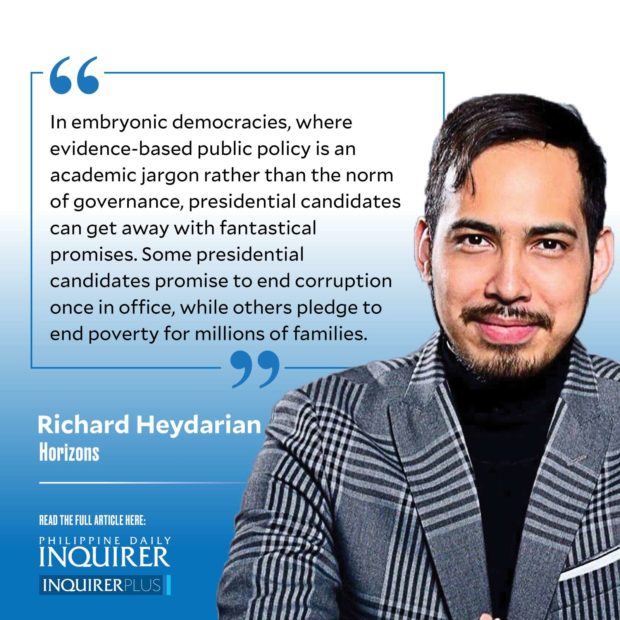Mission Impossible: Marcos’ economic agenda
In embryonic democracies, where evidence-based public policy is an academic jargon rather than the norm of governance, presidential candidates can get away with fantastical promises. Some presidential candidates promise to end corruption once in office, while others pledge to end poverty for millions of families.
Lo and behold, a candidate emerged victorious six years ago after promising to make us like “Singapore” by eliminating criminality within three to six months in office. And yes, he even promised to take a jetski to defend our claims in the West Philippine Sea. More recently, another victorious candidate promised to almost halve the price of staple foods such as rice once in office.
In the Philippines’ political simulacra, where curated images and catchy jingles trump substantive debates, the wilder the campaign promises, the safer it is. When faced with dysfunctional institutions, and bewildered by the mirage of democratic contestation, some voters seemingly prefer to latch onto magical realism than bother with difficult facts.
Once in office, however, even the most incorrigibly populist leaders will have to wrestle with the texture of reality, namely the iron law of policy tradeoffs. And dear reader, this brings us to the Marcos Jr. administration’s main agenda, namely economic recovery and a new era of prosperity for the Filipino people.
Ahead of President Marcos Jr.’s first State of the Nation Address (Sona), Finance Secretary Benjamin Diokno told counterparts in the G20 ministerial meeting, “The government’s medium-term fiscal framework is aimed at reducing the budget deficit, promoting fiscal sustainability, and enabling robust economic growth.”
On the surface, these policy goals seem perfectly reasonable. And we should laud our economic managers for their full commitment to an optimal economic outcome for the Filipino people. Upon closer examination, however, it’s crystal clear that the economic picture for the country is considerably more complex, thus requiring extraordinary leadership, technocratic competence, and political finesse from the Marcos Jr. administration.
Not long ago, the economic outlook for the Philippines seemed relatively bright after years of policy dithering and subpar leadership. Lest we forget, ours was the most economically devastated nation in the whole region during the initial phase of the COVID-19 pandemic. Between 2020 and 2021, the Philippines suffered five consecutive quarters of recession. The gross domestic product (GDP) contraction in 2020 was almost double-digit, among the worst in entire Asia.
What the World Bank once described as Asia’s “rising tiger economy” under the former Benigno Aquino III administration was now, once again, a regional laggard. Coming from such a low base, both in outcome and policy, Mr. Marcos’ presidency should have coincided, ceteris paribus, with the steep recovery phase. In short, the son of a former Filipino strongman couldn’t have asked for better timing to initiate his restoration project, all things considered.
In April, just weeks before Mr. Marcos’ victory, the Asian Development Bank forecasted a 6.0 percent GDP growth for the Philippines this year, and an even higher rate of 6.3 percent next year. Soon, however, it became clear that the new administration would have to deal with a combination of inherited and new economic challenges.
On one hand, Mr. Marcos inherited a ballooning debt, thanks to his predecessor’s massive borrowing, which brought the debt-to-GDP ratio to a 16-year-high, the worst since the Arroyo administration. But Diokno remained confident that his predecessor’s call for belt-tightening and “fiscal consolidation” was superfluous since good growth prospects and enhanced tax effort could do the trick.
Then, came the triple shock from Russia’s invasion of Ukraine, which disrupted global commodity markets, China’s economic slowdown, which further disrupted regional production networks and growth outlook, and America’s interest rate hikes, which dramatically drove down Asian currencies such as the Philippine peso. The upshot is the toxic cocktail of rising prices and declining growth across the world, with the threat of global “stagflation” lingering over the horizon.
Against this backdrop, it’s hard to see how the government can simultaneously avoid tax increases, expand targeted subsidies to vulnerable sectors, maintain infrastructure spending at 5-6 percent of GDP, achieve above-average annual growth rates of close to 8 percent, reduce the budget deficit by more than 60 percent in coming years, and slash the debt-to-GDP ratio from more than 60 percent to just above 50 percent in 2028. Welcome to real-world governance.
rheydarian@inquirer.com.ph





















